This homemade applesauce recipe starts with apples fresh from the backyard orchard or farmers market and results in a flavor-packed sauce. And it couldn’t be easier. Enjoy it fresh or dive in to learn about canning applesauce for the pantry.
This post was originally published in August, 2013. It has been updated.
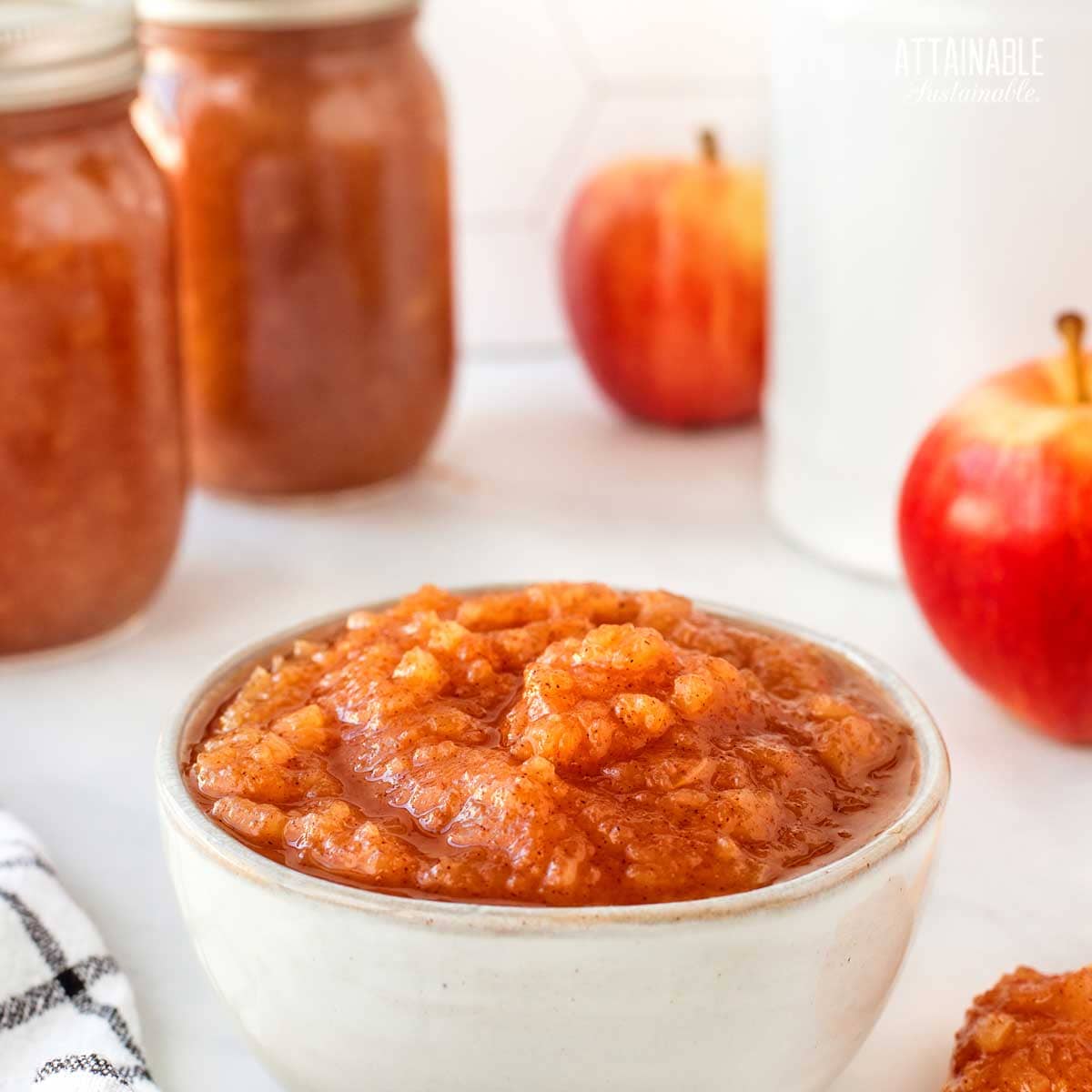
So many people look at me in surprise when they hear that I make applesauce instead of buying it at the store. It has simply never occurred to them to wonder how to make applesauce, they’re so used to buying it at the supermarket.
Let’s talk about that store-bought applesauce, though. If it’s all you’ve ever known, it probably tastes great to you. But to me? It has the texture of baby food, all finely ground and the same all the way through. And compared to homemade applesauce, the commercial version tastes watered down.
What if I told you that my homemade applesauce recipe tastes like apple pie served in a bowl? All that cinnamon goodness, with some chunks of apple. Serve it warm with a scoop of vanilla ice cream, close your eyes, and it’s easy to imagine that you’re eating apple pie.
5 Easy Steps to Transform Your Pantry!
Ready to switch from store bought to homemade? Let me help you make some changes! Grab my FREE five-part guide to getting started.
Easy Homemade Applesauce
I grew up on an apple farm. When one grows up on an apple farm, one gets a bit picky about applesauce. It should be nice and chunky, with lots of cinnamon, and it must be made from Gravenstein apples.
Of course, I jest and that last rule is entirely flexible. You can use any apple for this recipe, even the Golden Delicious or Granny Smith apples stocked at the supermarket. The flavor of the applesauce will change depending on the type of apple you use. You can read about different apple varieties here.
This is truly the easiest and best applesauce recipe! And doesn’t call for any added sweetener. If you start with sweet, ripe apples, the recipe just doesn’t need it.
The Handcrafted Pantry

Ready to DIY your pantry with more wholesome ingredients? Check out my ebook, The Handcrafted Pantry! Filled with delicious recipes for some of your favorite condiments, snacks, and toppings, it’s the guide you need to start skipping packaged products and embrace homemade.
Ingredients
Apples — Choose fresh medium or large sized apples. Any variety will work, though the flavor of the sauce will vary. This post about the best apples for baking will give you some ideas; they work just as well for making applesauce.
Liquid — Adding an inch or two of liquid to the cooking pot is necessary to prevent the apples from scorching. I like to use apple juice if it’s available, but plain water will work, too.
Spices — I love lots of cinnamon, but you do you. The cinnamon is purely for flavor and can be adjusted to make your mouth happy. You could also add a bit of nutmeg if you like.
Sweetener — I prefer canning applesauce without sugar; I find that the apples have plenty of sweetness, and sugar is not necessary for canning safety. If you have a sweet tooth, though, or you’re using less-than-sweet fresh apples, you can certainly add sugar, maple syrup, or honey to get the flavor just right. Add your favorite sweetener a little bit at a time, sampling as you go.
No Need for Perfection with this Homemade Applesauce
You’ll save a substantial amount of money if you track down a farmer who is willing to sell you her culls, or seconds. These apples are bruised or blemished, but perfectly fine for turning into homemade applesauce. Just trim out the bad parts and use the rest.
If you have a small orchard of your own, the apples that drop to the ground can be used in this homemade applesauce recipe. Simply cut out the blemishes and bruises, using the good portion of the apple that remains.
Cooking Method
This homemade applesauce recipe doesn’t require any measuring. How simple is that?
The “recipe” is more like a technique and you can make a batch of homemade applesauce as big (or small) as you like. Use this applesauce recipe for canning or serve it as an easy summertime side dish.
There’s a recipe card below, complete with measurements for those who are more comfortable with exactness. In reality, though? You don’t need to measure. You can easily make a batch of applesauce to suit your needs. I’ve made this in a huge stock pot. I’ve made a small batch of homemade applesauce in a saucepan.
This method shows you how to make applesauce no matter how much fruit you have on hand.
Here’s how you do it:
Peel, core, and slice apples into 1-2″ chunks. The smaller the chunks, the more quickly they’ll cook through. Use enough apples to fill your chosen pot. Use a saucepan for a small batch or a stock pot for a large batch.
Pour apple juice into your pot to a depth of about 1″ for a small batch, 2″ for a large batch.

Alternatively, you can do this in your slow cooker. Same drill: Fill the slow cooker with apple chunks, put about an inch of apple juice in the bottom, and cook on low all day.
Either way, this is great applesauce for canning and filling the pantry!
If you prefer a finer texture, you can run the applesauce through a food mill or food processor, but this is not something I do. [More on using a food mill here.]
Serve this homemade applesauce recipe warm or chilled, or proceed with canning steps below. (For an extra treat, drizzle a bit of this lemon fermented honey over the top!)
Love apples? Give this delicious French apple cake a try, too!
Canning Applesauce
Preserving applesauce is easy; in fact it’s one of the first things I learned to can at home. The applesauce recipe itself remains the same; canning applesauce is just the process of putting it in jars and processing it so that it’s shelf stable. No refrigeration required. If you’re new to canning, be sure to read all about the necessary equipment here.
🍅 Safety First!
Canning is an excellent way to preserve food for the pantry, but there are some important safety considerations to keep in mind. The recipes on this site have been made following safe canning procedures by a certified Master Food Preserver.
- Know the difference between water bath canning and pressure canning. Low acid items must be pressure canned for safety.
- Altering ingredients may change the recipe’s pH, posing a safety issue.
- Use the proper jars and lids. Never reuse lids, with the exception of the Tattler or Harvest Right hard plastic lids that are intended for such a purpose.
- For more on canning equipment, please go here.
- Want to learn more? The National Center for Home Food Preservation is the go-to resource for safe canning information.
If the pH of a jarred item is 4.6 or lower (4.2 in the tropics), it is safe to can using the water bath canning method. This recipe, using Gravenstein apples, tests at a pH of about 3.0.
For those of you searching to find out if canning applesauce safely without a water bath is possible, the answer is no. The jars must be processed to be shelf stable. Pressure canning is not necessary, though.
Here are the basic steps for safely canning this chunky applesauce recipe:
1. Start heating water in the canner
Applesauce can be processed using a boiling water canner. If you’re using a standard canner that holds a large volume of water, it takes awhile to bring it to a boil. Get it heating while you cook the applesauce. Fill the canner about halfway with water for pint jars, to within 2-3 inches of the top for quarts. You can also process smaller jars in a large pot; just be sure to place a trivet on the bottom so jars are slightly elevated from the bottom of the pot.
2. Transfer fruit mixture to jars
Ladle the hot apple sauce into hot jars. This recipe can be made in pint or quart-sized jars; the processing time varies depending on jar size. A canning funnel is a lifesaver for reducing spills.

Process jars of applesauce according to safe canning guidelines.
3. Watch your head space
Head space is the distance from the top of the jam to the rim of the jar. Some canning recipes require more head space than others. Home canned applesauce needs a one-half inch headspace.
4. Wipe the rims
Use a damp cloth to carefully clean the rim of each jar. Residue left on the jar rim can interfere with proper sealing.
5. Place the lids and rings on the jars
Set a lid (sometimes called a flat) on each clean jar rim. Screw a band onto the jar finger tight.
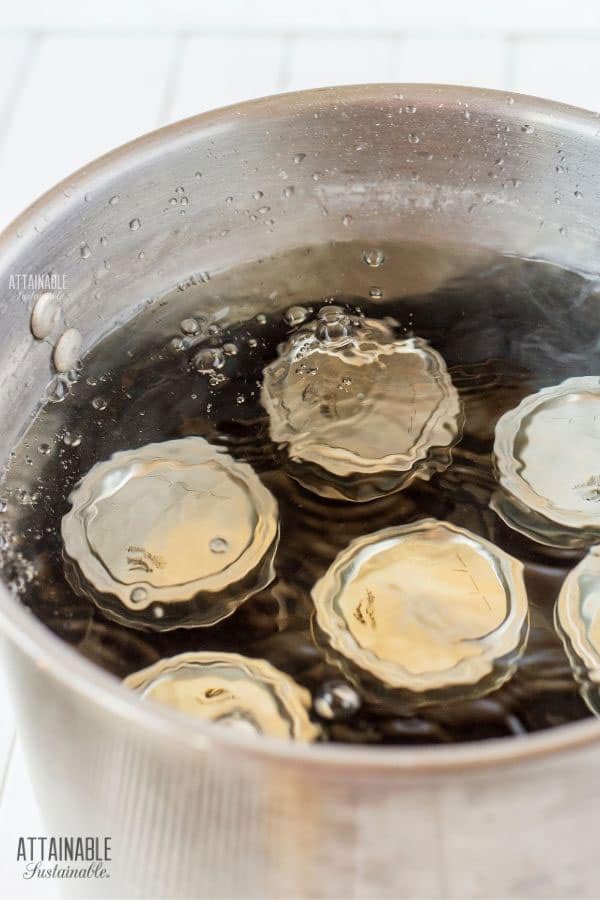
Process jars covered with a minimum of 1-2″ of water.
6. Process the jars
Pots dedicated to canning have a rack inside to prevent the jars from sitting on the bottom. Use a jar lifter (a must for canning!) to lift the filled jars into the boiling water bath canner one at a time.
Make sure that the jars are completely submerged. There should be at least an inch or two of water above the top of the jars. It’s a good idea to have a kettle with hot water on standby in case you need to top it off once the jars are in place.
Adding jars to the canner will lower the temperature of the water. Return the water to a boil, then start the timer to mark the processing time. You need to process this homemade applesauce for 15-20 minutes, depending on the size jar you choose.
7. Remove the jars from the canner
Again using the jar lifters, remove each jar from the canner and set on a towel-covered countertop. Leave the jars undisturbed until they cool thoroughly. You will likely hear the sound of the lids sealing with a little “tink!” as they cool.
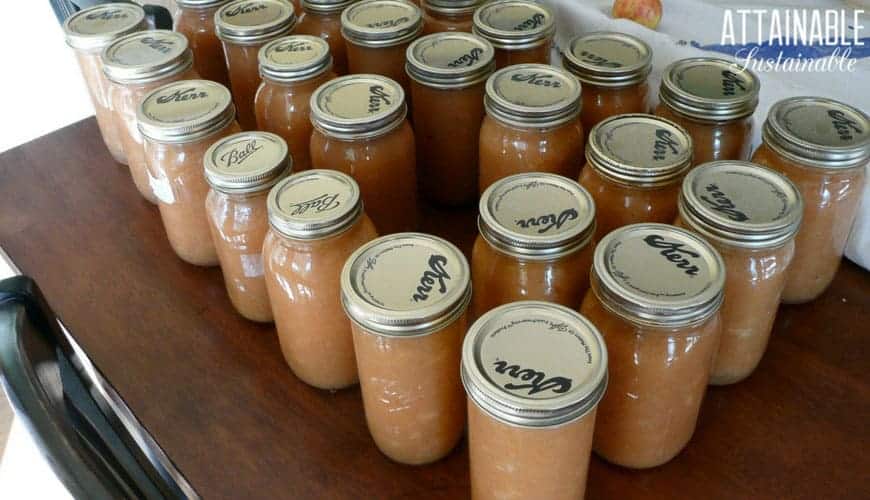
Jars of canned applesauce are shelf stable and ready for the pantry.
8. Check the seals
One the jars have cooled, check the lids to make sure they’ve sealed. Do this by pressing down in the center of each lid. It should feel solid. If the lid flexes up and down, it did not seal properly and the jar is not shelf stable. Place unsealed jars in the refrigerator and use within a week or so.
9. Storing canned applesauce
Remove the rings from the jars and wash each to remove any sugary residue that could attract ants. Dry and store jars without the rings. Storing jars with the rings will hold the lid in place, even if a seal fails. Store canned applesauce in the pantry for up to a year.
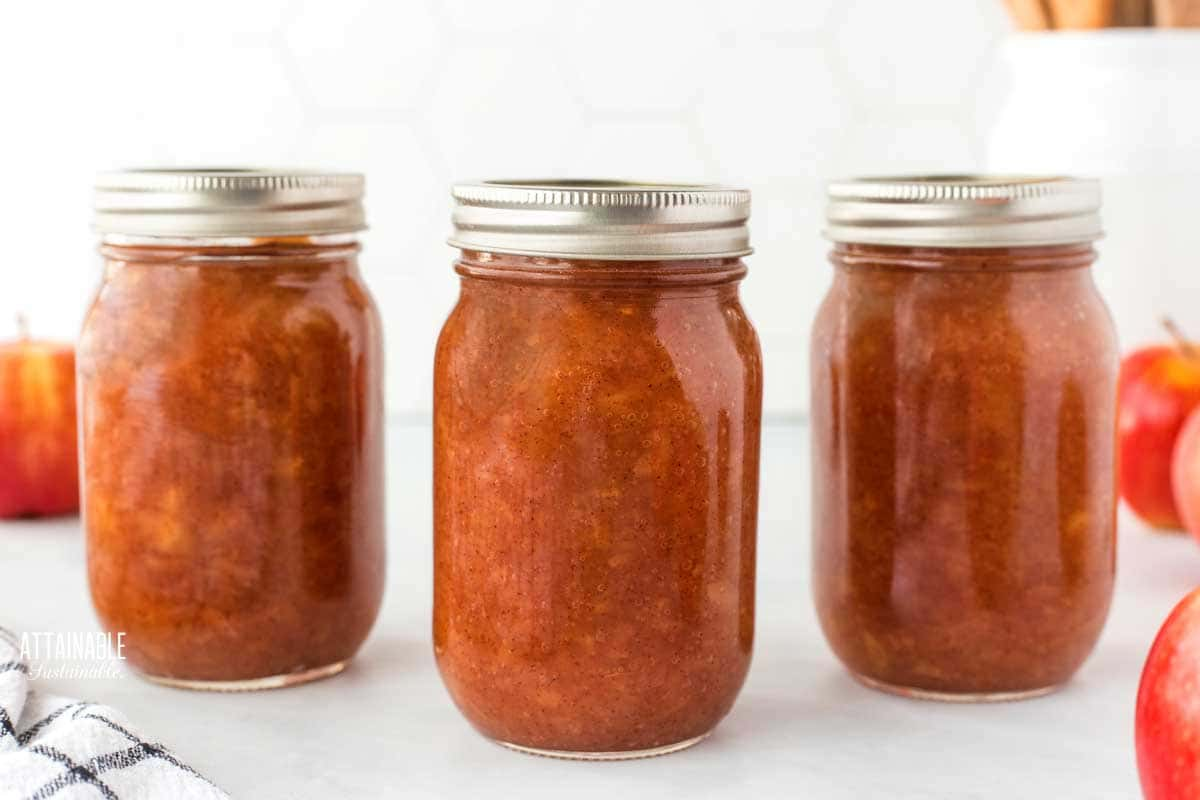
Store jars of applesauce in the pantry without the canning rings.
How long to water bath applesauce?
Return the water to a boil, then start the timer to mark the processing time. You need to process this homemade applesauce for 15-20 minutes, depending on the size jar you choose.
Can you freeze applesauce?
Yes! If you’re not ready for canning applesauce, freezing it is an easy way to preserve some for later. To do so, allow the applesauce to cool completely, then ladle into freezer safe containers. Be sure to allow 1-to-2-inches of head space, as the applesauce will expand some when it’s frozen. [More on that here.]
To thaw, set the applesauce out on a towel at room temperature. Stir before serving.
We eat this homemade applesauce by the bowlful, but if you’re looking for more ways to use canned applesauce, check out these sweet and savory ideas!
★ Did you make this homemade applesauce recipe? Don’t forget to give it a star rating below! ★
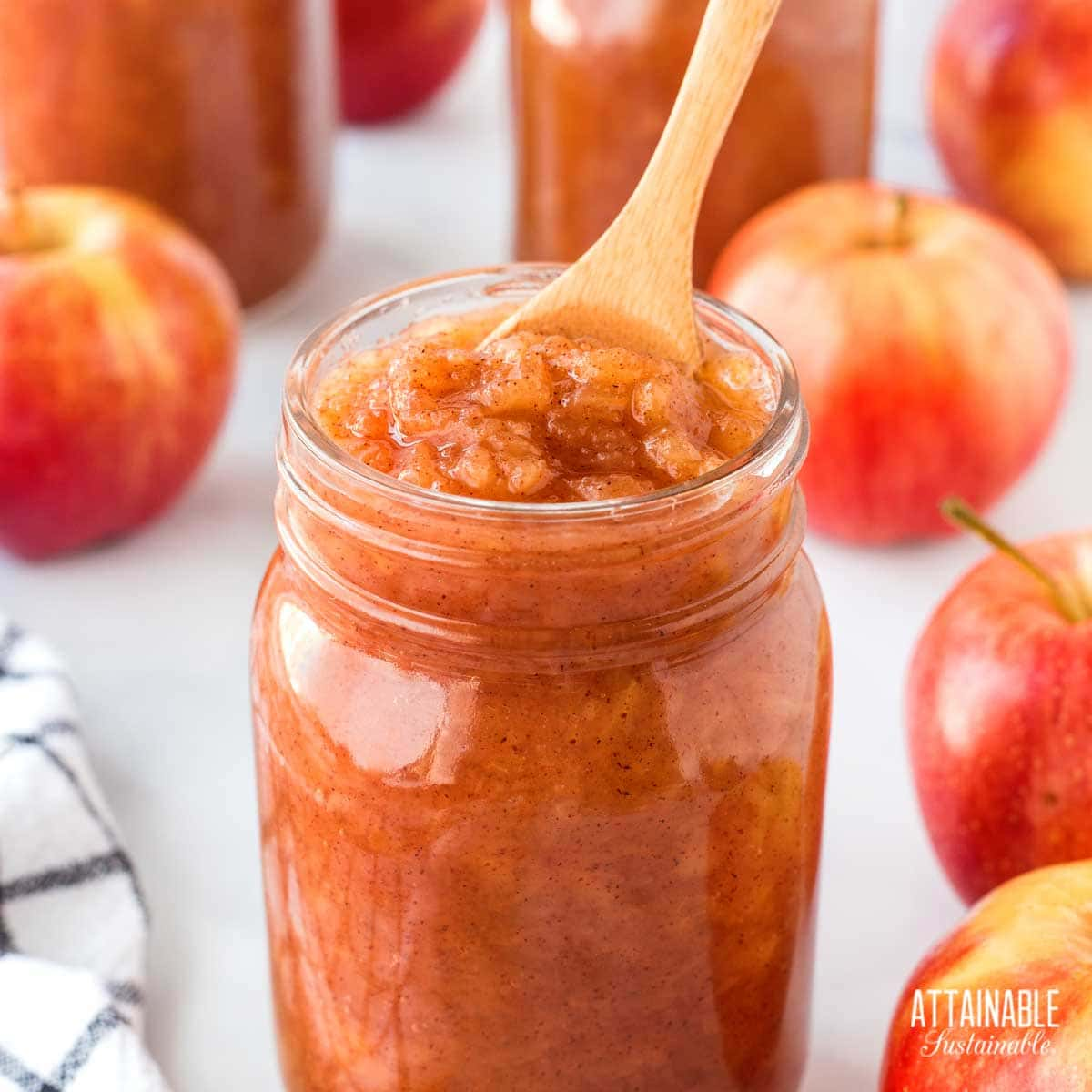
Homemade Applesauce Recipe
Ingredients
- 3 cups apple juice or water
- 8 cups apples chopped (about 3 pounds)
- 1 tablespoon ground cinnamon
Instructions
Making Applesauce
- Peel, core, and cut apples into roughly 1" chunks.8 cups apples
- Combine apples and apple juice (or water) in a large stock pot.3 cups apple juice
- SHORTCUT: You can skip measuring the ingredients entirely and simply fill a pot with apple chunks. Add juice or water to a depth of about 2" and cook as directed.
- Cover the pot and cook on low heat, stirring occasionally until apples become tender. Use a potato masher to break them up until your sauce reaches desired consistency.
- Stir in cinnamon.1 tablespoon ground cinnamon
- Serve warm or chilled, or proceed with canning steps below.
Prepare for Canning
- Wash the jars you'll use, making sure each is clean and free of nicks in the rim, which could impede sealing.
- Wash the lids and rings in hot soapy water. (If you're using non-Ball brand lids, prepare as suggested by manufacturer.)
- Place empty jars in a canning pot or large stock pot with enough water to cover by an inch or two, cover pot, and set on high heat to boil.
Canning Applesauce
- Remove jars from canner and drain.
- Ladle hot applesauce into warm pint or quart jars to within a half inch of the rim. A canning funnel makes this easy.
- Wipe jar rims to remove any applesauce that may have spilled. A clean rim is essential to a good seal.
- Set jar lids in place. Screw bands on finger tight.
- Use a jar lifter to gently submerge jars into boiling water in canning pot. Water should cover the top of the jars by an inch. The water will cool somewhat in reaction to the addition of the jars. Return the water to a low boil and then set the timer.
- Process in a boiling water bath. For pint jars, process for 15 minutes; 20 minutes for quarts at elevations up to 1,000 feet. Adjust timing for altitude as follows: Process pint jars for 20 minutes between 1,001 and 6,000 feet and 25 minutes over 6,001 feet. Process quart jars for 25 minutes between 1,001 and 3,000 feet, 30 minutes between 3001 and 6,000 feet, and 35 minutes over 6,001 feet.
- Check seals. Lids should be solid and pulled down tight. (if they flex and pop, the jar didn’t seal; put unsealed jars in the refrigerator and use those first).
- Remove rings and wash outsides of jars. Store in a cool, dry place.
Notes
- Alternatively, you can do this in your slow cooker. Same drill: Fill the slow cooker with apple chunks, put about an inch of apple juice in the bottom, and cook on low all day.
- This applesauce recipe can be made with varying amounts of apples. You don’t need to measure. You can easily make a batch of applesauce to suit your needs. I’ve made this in a huge stock pot. I’ve made a small batch of homemade applesauce in a saucepan.
- Peel, core, and slice apples into 1-2″ chunks. The smaller the chunks, the more quickly they’ll cook through. Use enough apples to fill your chosen pot. Use a saucepan for a small batch or a stock pot for a large batch.
- Pour apple juice into your pot to a depth of about 1″ for a small batch, 2″ for a large batch.
- This recipe tests at about a 3.0 pH using Gravenstein apples.
- If you've got more than you can use but don't want to go through the canning process, you can freeze it, too.
- Boiling lids or heating above 180°F as once recommended can damage the sealing compound.

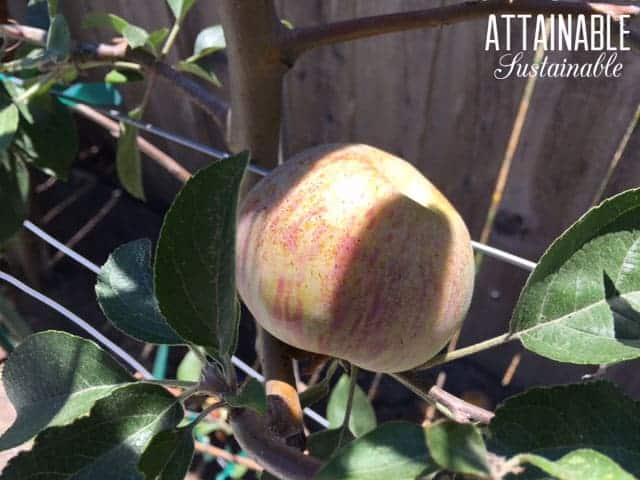
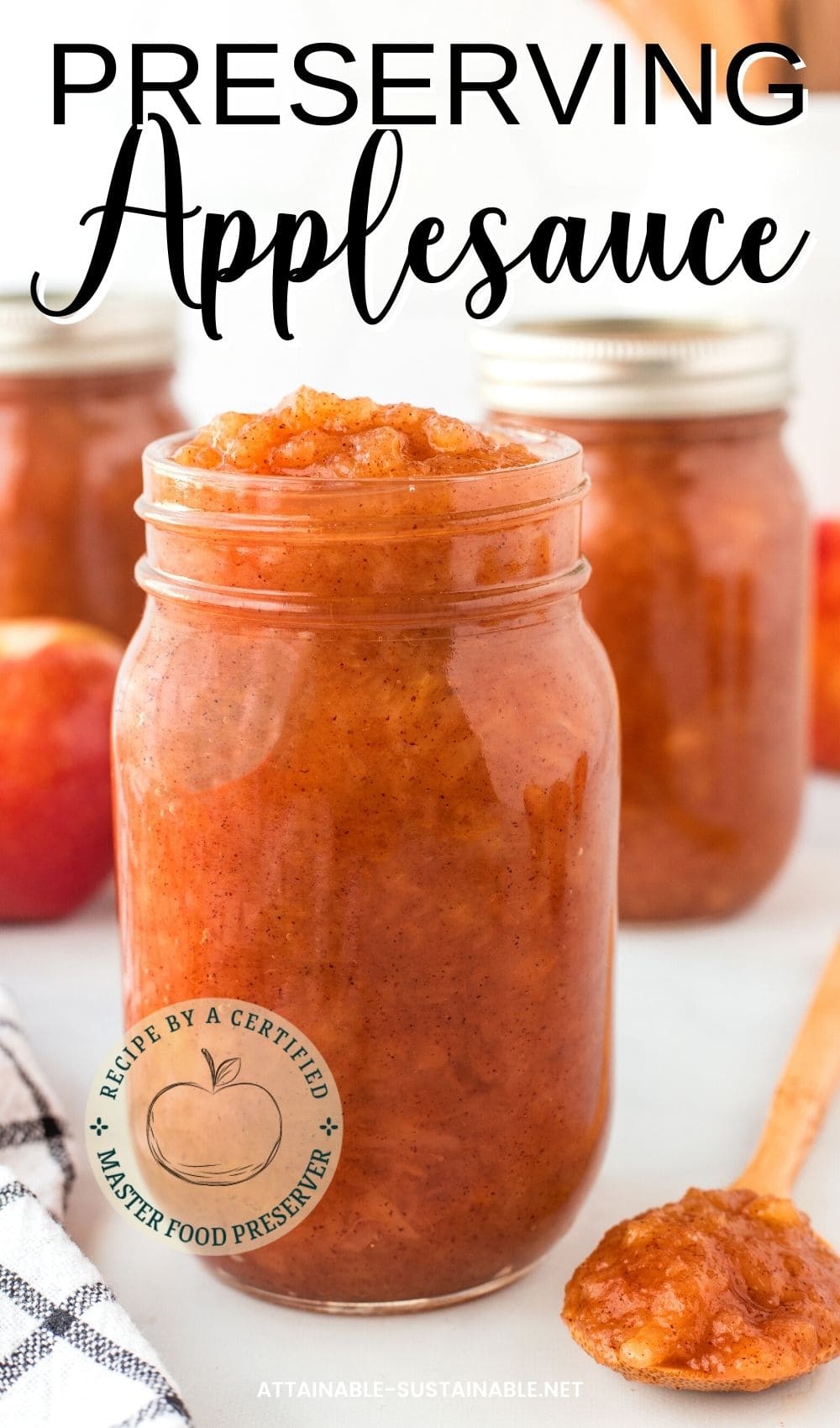
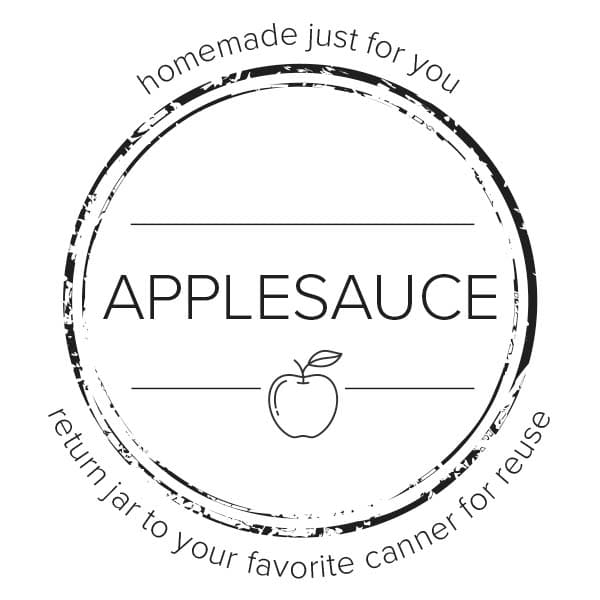

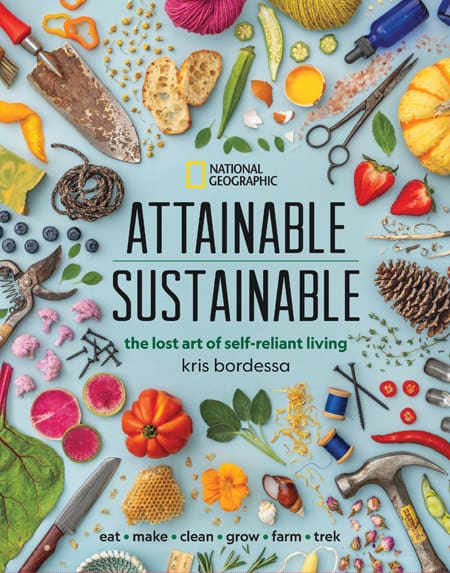
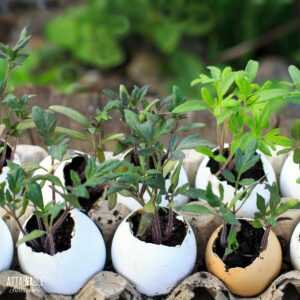
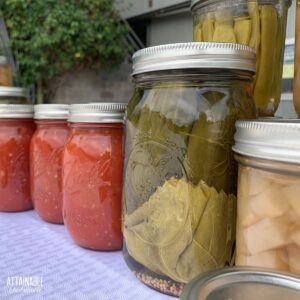
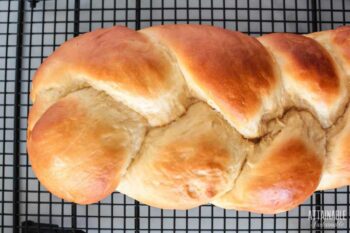
Newbie Canner here! I would prefer to keep the peels on my fruit. Would that alter the ph of the fruit snd affect the processing at all? or can I keep the peels on the apples and process as per this recipe?
The trouble with the peels is that they can carry a bacterial load. National Center for Home Food Preservation calls for peeling them.
Thanks
You’re welcome 🙂
.ade and canned it today. Taste is great love your information and receipe
Love to hear that!
Could I add carrots and still can it? Like 1/2 apple 1/2 carrot? I have so many carrots and apples that need to be hsed
NO. Carrots are a low acid food and it will alter the pH, making the recipe unsafe for water bath canning.
How many pints does one recipe fill? I make double batches so I’m trying to guesstimate.
Three, as written.
Thanks for such a versatile applesauce recipe while also reassuring about safety for home canners. Agree that Gravenstein apples are the best as an old fashioned favorite here. We’re almost through processing 100 lbs and will have plenty of apple pie filling, applesauce and apple butter to see us theough the inflationary days yet to come this winter. Blessed be and keep on canning, folks!
Woo-hoo, that’s a lot of apples! You’re welcome, glad you loved the recipe!
I would say for anyone following the recipe, I would measure 10 cups of apples, it’s better to have left-over applesauce than not enough to fill a jar, like what just happened to me.
Also, what do we think about adding lemon juice, some say definitely yes, some say you don’t need to.
True, too much is better than not enough! The addition of lemon juice to acidify is not necessary here, but it won’t hurt to add it.
How long can you store canned applesauce? What is the shelf-life?
About a year.
I have not been on your site before but you got me at gravensteins are the apple for sauce…and pie in my opinion. Don’t get me started on the transparency of transparents! My mil and i disagree on that one.
Dried apples are also good although time consuming. My kids are taking them back packing this weekend.
Here’s to a good crop of gravensteins this year…and prune plums.
Yep, best for pie, too!
How long is this good in the refrigerator for? Do i need to add anything for preserving?
It should last – as is – in the fridge for 10 days or so. If you need to preserve it longer, either can it or freeze it.
Delicious!
We have had such a bumper apple crop the past few years at our place, we have had to get a bit creative with how we preserve our apples. We have tried sauce, cider, juice, but the most effective for our family was making a bunch of stewed apple slices, like we did here: https://bit.ly/1Cc276Y. Great share 🙂
So how many pounds do you do on average? Any any apple juice?
In past years – living in apple country – I’d do about 120-150 pounds each year. My dad has a cider press, so we let him do the making of apple juice. 😉
Hi! I see you say to add apple juice. Right now I only have apple cider from our local farm. Is that ok to use? Thanks!
But then weʻd have to get into a whole conversation about the difference between juice and cider! (Cider is generally the term for fermented apple juice, but a lot of people use the term interchangeably, calling fresh squeezed apple juice “cider.” I sounds more old fashioned, doesnʻt it?) Short answer, yes. 😉
Juice vs cider is actually the extraction process. Cider is cold press, juice is heat processed.